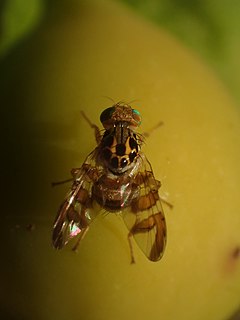Vidalia is a genus of tephritid or fruit flies in the family Tephritidae. Vidalia are commonly found distributed from the Eastern Palearctic to Oriental and Australasian. They breed in the fruits of Schefflera subulata, a member of Araliaceace, in West Malaysia.

The Tephritidae are one of two fly families referred to as fruit flies, the other family being the Drosophilidae. The family Tephritidae does not include the biological model organisms of the genus Drosophila, which is often called the "common fruit fly". Nearly 5,000 described species of tephritid fruit fly are categorized in almost 500 genera of the Tephritidae. Description, recategorization, and genetic analyses are constantly changing the taxonomy of this family. To distinguish them from the Drosophilidae, the Tephritidae are sometimes called peacock flies, in reference to their elaborate and colorful markings. The name comes from the Greek τεφρος, tephros, meaning "ash grey". They are found in all the biogeographic realms.

Acidia is a small genus of flies in the family Tephritidae. It formerly contained many species, but by some authors has since been restricted to two.
The Blepharoneurinae are a subfamily of the fruit fly family Tephritidae comprising five genera and 34 species.

The Tephritid Workers Database is a web-based database for sharing information on tephritid fruit flies. Because these species are one of the most economically important group of insect species that threaten fruit and vegetable production and trade worldwide, a tremendous amount of information is made available each year: new technologies developed, new information on their biology and ecology; new control methods made available, new species identified, new outbreaks recorded and new operational control programmes launched. The TWD allows workers to keep up-to-date on the most recent developments and provides an easily accessible and always available resource.
Ceratodacus is a genus of tephritid fruitfly. The type species C. longicornis is found in South America in Brazil, Guyana and Peru. Nothing is known about its host plant. A second species, C. priscusNorrbom & Condon, 2000 has been described from Dominican amber.

Anastrepha is the most diverse genus in the American tropics and subtropics. Currently, it comprises more than 300 described species, including nine major pest species, such as the Mexican fruit fly, the South American fruit fly, the West Indian fruit fly, the sapote fruit fly, the Caribbean fruit fly, the American guava fruit fly, and the pumpkin fruit fly, as well as the papaya fruit fly. As some of their names suggest, these pest species are one of the most numerous and damaging groups of insects in their native range, plaguing commercial fruits such as citrus, mango, guava, and papaya.

Carpomya is a genus of tephritid or fruit flies in the family Tephritidae.
Urelliosoma is a genus of tephritid or fruit flies in the family Tephritidae. It is considered a synonym of Trupanea.
Problepharoneura is a fossil genus of Tephritid or fruit flies in the family Tephritidae for the sole species, Problepharoneura antiqua, described on the basis of single male specimen found in Upper Eocene amber from the Dominican Republic.
Tachiniscidia is a genus of Tephritid or fruit flies in the family Tephritidae. Several species appear like wasps.

Rhagoletis suavis, also known as the walnut husk maggot, is a species of tephritid or fruit fly in the family Tephritidae. This fly is closely related to, but not to be confused with, Rhagoletis juglandis, or the walnut husk fly. It occurs in North America.
Zonosemata electa is a species of tephritid or fruit flies in the genus Zonosemata of the family Tephritidae.

Goniglossum wiedermanni is a species of tephritid or fruit flies in the family Tephritidae, and the only species in the genus Goniglossum.
Freidbergia is a genus of tephritid or fruit flies in the family Tephritidae.
Stelladesis is a genus of tephritid or fruit flies in the family Tephritidae.
Tephrodesis is a genus of tephritid or fruit flies in the family Tephritidae.
Trupanodesis is a genus of tephritid or fruit flies in the family Tephritidae.

Myopitini is a tribe of tephritid or fruit flies in the family Tephritidae.
Freidbergia mirabilis is a species of tephritid or fruit flies in the genus Freidbergia of the family Tephritidae.







